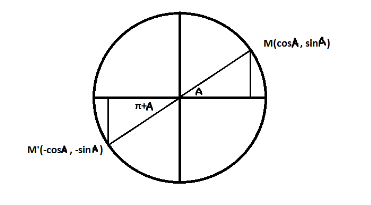Answer
385.8k+ views
Hint: Imagine a unit circle and assume an angle, θ. Mark the corresponding coordinates $ (\cos \theta ,\sin \theta ) $ on the circle. The angle in the question is π more than the unknown angle. In the circle the coordinates corresponding to $ (\pi + \theta ) $ is $ ( - \cos \theta , - \sin \theta ) $ . Thus, we see the sine function for θ has changed to negative sine function upon addition of π.
Complete step-by-step answer:
Let us visualize a circle with unit radius and center at origin. Then we mark the angle A on the positive $ (x,y) $ axis. The corresponding point on the circle “M” is $ (\cos A,\sin A) $ . When the angle is changed to $ (\pi + A) $ , the point “M’” has the coordinates $ ( - \cos A, - \sin A) $ as they are located in the III quadrant, i.e., negative x and y axis.
And hence we see, $ \sin (A + \pi ) = - \sin A $ .

Alternate method: Using the identity of summation of angles in the sine function, we can also verify the above asked identity.
We know that, $ \sin (a + b) = \sin a.\cos b + \sin b.\cos a $
Putting $ a = \pi \& b = A $ in the above identity,
$ \sin (\pi + A) = \sin \pi .\cos A + \sin A.\cos \pi \\
Since
\sin \pi = 0 and \cos \pi = -1
we have
$ \sin (A + \pi ) = - \sin A $
Hence, verified.
Note: The functions sine, cosine and tangent of an angle are sometimes remarked as the primary or basic trigonometric functions. The remaining trigonometric functions secant (sec), cosecant (csc), and cotangent (cot) are defined as reciprocals of cosine, sine, and tangent, respectively. Trigonometric identities are equations involving the trigonometric functions that are true for each value of the variables involved.
Complete step-by-step answer:
Let us visualize a circle with unit radius and center at origin. Then we mark the angle A on the positive $ (x,y) $ axis. The corresponding point on the circle “M” is $ (\cos A,\sin A) $ . When the angle is changed to $ (\pi + A) $ , the point “M’” has the coordinates $ ( - \cos A, - \sin A) $ as they are located in the III quadrant, i.e., negative x and y axis.
And hence we see, $ \sin (A + \pi ) = - \sin A $ .

Alternate method: Using the identity of summation of angles in the sine function, we can also verify the above asked identity.
We know that, $ \sin (a + b) = \sin a.\cos b + \sin b.\cos a $
Putting $ a = \pi \& b = A $ in the above identity,
$ \sin (\pi + A) = \sin \pi .\cos A + \sin A.\cos \pi \\
Since
\sin \pi = 0 and \cos \pi = -1
we have
$ \sin (A + \pi ) = - \sin A $
Hence, verified.
Note: The functions sine, cosine and tangent of an angle are sometimes remarked as the primary or basic trigonometric functions. The remaining trigonometric functions secant (sec), cosecant (csc), and cotangent (cot) are defined as reciprocals of cosine, sine, and tangent, respectively. Trigonometric identities are equations involving the trigonometric functions that are true for each value of the variables involved.
Recently Updated Pages
How many sigma and pi bonds are present in HCequiv class 11 chemistry CBSE

Why Are Noble Gases NonReactive class 11 chemistry CBSE

Let X and Y be the sets of all positive divisors of class 11 maths CBSE

Let x and y be 2 real numbers which satisfy the equations class 11 maths CBSE

Let x 4log 2sqrt 9k 1 + 7 and y dfrac132log 2sqrt5 class 11 maths CBSE

Let x22ax+b20 and x22bx+a20 be two equations Then the class 11 maths CBSE

Trending doubts
Fill the blanks with the suitable prepositions 1 The class 9 english CBSE

At which age domestication of animals started A Neolithic class 11 social science CBSE

Which are the Top 10 Largest Countries of the World?

Give 10 examples for herbs , shrubs , climbers , creepers

Difference between Prokaryotic cell and Eukaryotic class 11 biology CBSE

Difference Between Plant Cell and Animal Cell

Write a letter to the principal requesting him to grant class 10 english CBSE

Change the following sentences into negative and interrogative class 10 english CBSE

Fill in the blanks A 1 lakh ten thousand B 1 million class 9 maths CBSE



